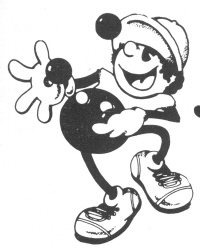The hour was late but the party was young. A dozen or so lJA officers and assorted other jugglers who attended the Winter Business Meeting were gathered that evening at secretary/treasurer Rich Chamberlin's house for merrymaking. Infused
with the same buoyant spirit that accompanies all jugglers'
gatherings, we joyfully watched convention movies, admired
Chamberlin's dozen original Harry Lind wooden clubs and refused to
recognize that it was past our bedtimes.
The
close confines and abundance of fine glassware in Chamberlin's house
delayed actual juggling, but you could tell everyone was in the mood.
Finally, about 11 p.m., under the pretense of doing research for this
month's feature article on numbers juggling, I asked Michael Kass, lJA
vice president, to juggle for me.
During
my interviews for the article, people claimed that an increase in
numbers of objects was accomplished by raising the height of the
pattern rather than quickening the throws. About two throws per second
per hand was the limit, I was told. Kass enthusiastically agreed to be
my guinea pig for some timing experiments.
With
stopwatch in hand, I counted throws as Kass tossed his best for
science. The results shed very little light on the numbers article
because Kass can only juggle five balls well. But he can do them very
fast - faster in fact than two throws per hand per second.
In a series of about ten trials juggling at his absolute minimum height and maximum speed, Kass averaged slightly over 2.8 throws per hand per second. When he raised the pattern to its normal height, the speed dropped to 2.23 throws per hand pet second. We
were both thoroughly excited by our rudimentary experiment, and pushed
on to record times for other patterns.
.
A
fast-as-possible three ball cascade yielded 2.25 throws per hand per
second, about the same as a normal five. That result may imply
something, but is only fodder for further research now.
I
was curious about clubs, and Kass was happy to oblige. Despite the
possibility of destroying valuable personal property and bringing
severe and justified wrath upon our heads, he performed coolly and
flawlessly.
Club
cascades logically were a bit slower than ball cascades. However, it
was interesting to note that club juggling with single throws was
barely faster than with double spins - 1.8 per hand per second as
opposed to 1.75.
Club
tricks proved to cost vast amounts of time. Kass's continuous single
back crosses, though they seem to be speedy, only require I. 25 tosses
per hand per second. Continuous kickups, his beautiful trademark
trick, left him plenty of time to yawn at only .65 throws per hand per
second.
So
the experiment concluded. Nothing but data was actually determined,
but it's data I've wanted to collect for a long time. The measurement
of juggling performance seems important to me in this high-technology
era.
It
seemed important in writing the feature article, and I fear the
finished product suffers for lack of it. I was able to include only
the number of objects that different people juggle, but could not find
out interesting and potentially important details such as the height
of their patterns and speed of their tosses.
Perhaps
that information is trivial. After all, the bottom line is how many
objects can be handled for how long. But my curiosity about the
mechanics of the human body and respect for juggling demand that I
record quantifiable observations of it.
I
hope other people fee! the same way, and that part of the legacy of
the IJA may be accurate data on juggling and jugglers of our time.
Future historians, if no one else, will appreciate the effort. ...... Ambling
through Newark Airport on my way back from the business meeting, I
spied "New York" magazine displaying a mime-faced club
juggler and pretty model intertwined on the cover. It was Fred
"Garbo" Garver, IJA member, taking the lead in a multi-page
photo essay of the latest fashions which combined professional models
with typical New Yorkers, i.e. - cab drivers, policemen, graffiti
scrawlers and hot dog vendors. Garbo qualified as a typical Broadway
star, due to his 18 month appearance in "Barnum."
However,
he has now departed that production to work with Michael Moschen and
Bob Berky, staging shows of their own. The trio's fIrst venture will
be a one-hour show at the Dance Theatre Workshop, 19th St. and 7th
Ave. in New York City, at 11 p.m.
April 16, 17, 23, 24, 30 and May 1. This summer, they will teach an
Antic Arts Academy as part of the summer arts program at the State
University of New York in Purchase. Toward the end of the summer, they
will be in Scotland at the Edinburgh Festival.
Congratulations,
Garbo! Be sure and tell 'em about the lJA out there in the big time! |
